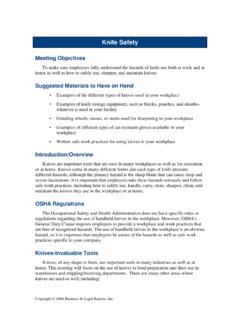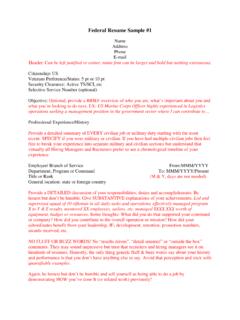Transcription of Knife Safety - First Benefits Insurance Mutual
1 Copyright 2006 Business & Legal Reports, Inc. Knife Safety Meeting Objectives To make sure employees fully understand the hazards of Knife use both at work and at home as well as how to safely use, sharpen, and maintain knives. Suggested Materials to Have on Hand Examples of the different types of knives used in your workplace Examples of Knife storage equipment, such as blocks, pouches, and sheaths-whatever is used in your facility Grinding wheels, stones, or steels used for sharpening in your workplace Examples of different types of cut-resistant gloves available in your workplace Written safe work practices for using knives in your workplace Introduction/ overview Knives are important tools that are used in many workplaces as well as for recreation or at home. Knives come in many different forms and each type of Knife presents different hazards, although the primary hazard is the sharp blade that can cause deep and severe lacerations.
2 It is important that employees take these hazards seriously and follow safe work practices, including how to safely use, handle, carry, store, sharpen, clean, and maintain the knives they use in the workplace or at home. OSHA Regulations The Occupational Safety and Health Administration does not have specific rules or regulations regarding the use of handheld knives in the workplace. However, OSHA's General Duty Clause requires employers to provide a workplace and work practices that are free of recognized hazards. The use of handheld knives in the workplace is an obvious hazard, so it is important that employees be aware of the hazards as well as safe work practices specific to your company. Knives-Invaluable Tools Knives, of any shape or form, are important tools in many industries as well as at home.
3 This meeting will focus on the use of knives in food preparation and their use in warehouses and shipping/receiving departments. There are many other areas where knives are used as well, including: Copyright 2006 Business & Legal Reports, Inc. 1. Carving wood or other materials 2. Cutting rope or twine 3. Cutting fabric, carpet, drywall, etc. 4. Fishing and hunting Discuss why knives are used in your workplace as well as why you use knives at home. Types of Knives Knives come in hundreds of different varieties, such as: Pocketknife Single-blade Knife Utility Knife Razor blade scraper Snap-off blade Knife Hunting Knife Machete Vegetable Knife Meat-cutting Knife Bread Knife Shellfish Knife Bring examples of the different types of knives that are used in your workplace.
4 Selecting the Correct Knife Knives come in many different shapes and forms, each one designed for a specific purpose or job. Selecting the correct Knife for the job is very important to ensure that the job can be completed correctly and safely. When selecting a Knife , consideration should be given to the following: Knife blade: What is the appropriate Knife blade for the job required? Are you cutting fish, shellfish, beef, wood, cardboard, bread, Should the blade be firm or flexible? Should the blade be retractable? Retractable blades are frequently used in workshops and shipping departments Copyright 2006 Business & Legal Reports, Inc. because they can be safely left on a workbench when the blade is retracted. Knife edge: What type of edge is best for your purpose? Fine edged blades produce a smooth, clean cut.
5 Serrated blades are good for cutting food products with a skin or crust and a soft interior. Serrated blades are also used for cutting cardboard cartons and similar packing materials. Handle size: Is the handle large enough to provide a secure grip? This prevents the hand from slipping forward over the blade and reduces the force required to hold the Knife . Handle design: Is the handle designed to reduce excessive wrist bending? The principle is to use the tool, not the wrist. Handle material: What is the handle made of? Handles used in the food industry should be made of non-absorbent materials that are resistant to fat and oils to prevent them from becoming slippery and unhygienic. Wood handles should not be used in the food industry. Handle grip: How is the grip formed?
6 When holding the Knife , the grip should be spread so that it is even along the handle. Comfort: Does the Knife feel comfortable? If not, musculoskeletal injuries may develop if the Knife is used frequently. Parts of a Knife All knives have similar parts: Point-the very tip of the blade Back edge of blade-the unsharpened, or dull, edge of the blade steel Cutting edge-the sharpened edge of the blade steel Bevel-forms the cutting edge when the edge of the blade steel is ground down at an angle on both sides to come to a sharp point. The size of the bevel should be the same on both sides of the cutting edge in order to have a straight cut. Shoulder-where the bevel angle meets the straight, ungrounded, blade steel Heel-the part (often not sharpened) of the cutting edge closest to the handle Copyright 2006 Business & Legal Reports, Inc.
7 Bolster-a collar or shank on some knives, at the point where the blade meets the handle Tang-a continuation of the blade that extends into the Knife 's handle Knives used for heavy work, such as chef's knives or cleavers, should have a full tang, that is, a tang as long as the entire handle. Handle-the part of the Knife that the user holds Safety stop- the part of the handle closest to the blade that prevents the user's hand from slipping forward onto the blade Grip-area of the handle that the user's fingers wrap around so the user can comfortably hold and use the Knife without it slipping Butt-the end of the handle that prevents the user's hand from slipping off the back end of the Knife handle Point out these different parts on one of the knives commonly used in your workplace.
8 Hazards of a Knife The type of Knife used and how it is handled, sharpened, and maintained are very important in achieving the desired results. All of these factors are also essential for worker Safety and preventing injuries. The type of injuries that occur from the unsafe use of knives range from small nicks to serious disabling cuts. Other injuries related to the repeated and long-term use of knives can include wrist strains and sprains. Dull Knife A dull Knife is dangerous; it will slide when you want it to cut, and then, when it stops sliding, it will cut, usually somewhere you didn't want it to cut, like your hand. Dull knives also cause people to put more effort into cutting, which encourages unsafe and awkward cutting positions. To avoid such accidents, it's a good idea to learn how to sharpen your Knife properly or know when to take it to an expert for sharpening.
9 Using Knives Safely The basics of safely using a Knife include: Making sure the area around you is clear-creating a Knife Safety circle Grasping the Knife handle with your whole hand Cutting away from your body Knife Safety Circle Copyright 2006 Business & Legal Reports, Inc. To establish a Knife Safety circle: Pretend you have a Knife in your hand. Extend your arm with the pretend Knife straight in front of you. Rotate your body to either side while continuing to extend the arm with the pretend Knife . Also check your overhead clearance, as this is also part of your Safety circle. No person or thing should be in the imaginary circle you have created. Proper Grip Hold the Knife firmly by the handle. Wrap your fingers completely around the handle so you have a firm grip.
10 Never press on the back edge of the blade when cutting. If the Knife slips out of your hand-do not attempt to catch it! Get out of the way and let it fall. Cutting Direction Always cut in a motion away from your body and away from other people. This way, if the Knife slips, it will not cut your body or the body of a person standing near you. Keep your other hand, fingers, and thumbs out of the way of the cutting line. If you have to grip the object you are cutting, then cut away from your hand. Never cut toward your hand or your body! Stay focused on the cutting job. Do not allow your mind to wander and do not talk with co-workers while using a Knife . When interrupted, stop cutting and place the Knife down on a secure surface. Do not try to cut while distracted! When you have finished using a Knife , clean it, put it away immediately, and store it properly.


